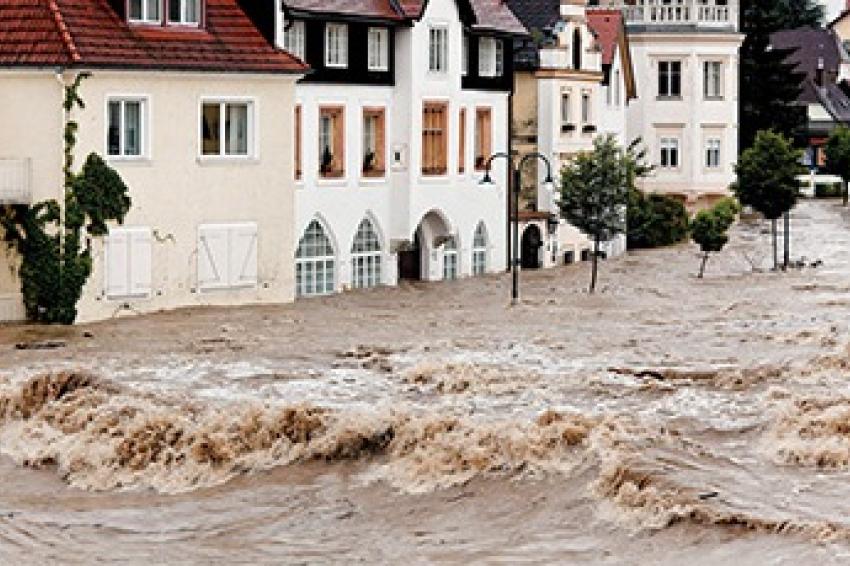Video Management: Flood Alert
08.11.2013 - The severe floods of 2002 and 2013 have impressively shown the immense extent of damage that natural events can cause in our intensively farmed and densely populated landscape. In ...
The severe floods of 2002 and 2013 have impressively shown the immense extent of damage that natural events can cause in our intensively farmed and densely populated landscape. In both cases, numerous rivers were affected, among others some in the South and East of Germany, Austria and the Czech Republic. In Germany alone, the flood of 2002 brought about damage amounting to approximately €11 billion.
In summer 2005, a storm in the Alpine region also led to floods, resulting in a great deal of devastation. While in mountain regions accidents and damage were mainly caused by landslides, the overflowing rivers and lakes were the problem in the lowlands. Natural disasters cannot be avoided, but the consequences can be significantly reduced through preventive measures. For this reason, the Swiss canton Uri, which was particularly affected by the storm, decided to be better equipped for future floods with the help of a video surveillance system.
The Theoretical Flow
The water engineering department of the canton relies on a video management system to protect particularly vulnerable areas. Hence, video cameras should monitor the level of the local waters at strategically important locations. The areas of overflow spillways (dikes) and flood buildings (driftwood grills, delay basins) should be provided with a reliable solution that runs stably under extreme external conditions and that can be operated intuitively.
Another important criterion was the gradation of the rights of use. Access to the system's images should be granted to numerous employees to ensure 24/7 surveillance, while operation and configuration (e.g. an export of the recordings) should only be available to selected members of staff. To protect the privacy rights of randomly recorded people passing by, the cantonal operator required differentiated authorization groups. Since no security system had been in use for the early warning of floods before, an external office was entrusted with creating a list of requirements for implementation in 2011. The requirements of the engineering office of R. Stöckli AG from Zurich were subsequently implemented locally by ParCom Systems. On their recommendation, the client chose the software solution of the German company SeeTec AG.
Before the Rainfall
The implementation of the video management system started promptly. The modular system concept of the SeeTec Multi Solution Platform provides numerous options and features that meet the customers' individual wishes. Thus, the user is provided with a variety of clients that can optionally be activated or deactivated. In addition, external systems such as burglar alarm systems, intercoms or lighting systems can be operated directly on the SeeTec surface via I/O modules.
Outdoors, video cameras from Axis Communications are in use at 13 locations along river beds. Specifically designed for outdoor use, the cameras are equipped with a robust housing and thus provide clear images even under extreme conditions. The cameras keep an eye on strategically selected points so that a rise of the water level can be detected and reported immediately. The central control station of the system is located at the Civil Engineering Office in Altdorf, the canton's main location. The staff here has full access to the installed cameras and is able to configure and control them. 30 workstations are available to the administration. In total, more than 40 users, also including external emergency organizations such as local fire brigades, have access to the live images.
Who Sees What
What is of crucial importance for the cantonal administration is the finely graduated and flexible assignment of user rights in the client software. Thus, external users defined previously are able to view camera recordings, but can neither export them nor change system settings. "The different user rights and the software's user interface, which can be operated intuitively, approach an easy handling. Basic system training was carried out within a very short period so the performance of both hardware and software is paramount", said Mirco Stadelmann, Project Manager at the partner ParCom Systems. In addition to the surveillance cameras, fixed lighting is connected with the SeeTec system via Internet by means of an I/O module and a UTMS router installed at each site. This allows the staff to operate the lighting remotely and, in case of poor visibility conditions or at night, the light at any camera location can be switched on to be able to recognize emergencies at an early stage. The site plan displayed in the software contains the locations of the installed hardware and shows the current status of the lighting (on or off) via integrated lamp icons.
In addition, SeeTec Anywhere software is integrated into the platform by the manufacturer, Citrix, so that authorized employees are also able to connect to the video system remotely via their usual application. A prior installation of the SeeTec software on the individual workstations is not necessary, simplifying practical usage in everyday life.
Fritz Epp, Head of the Water Maintenance Department at the management of the canton Uri, is extremely satisfied with the result. "The installed solution has decreased our workload and effort immensely. It allows us to detected danger early and to take preventive measures for the protection of entire villages and communities. We do not have to physically check on site if everything is in order all the time but can now easily view the situation from the control station."
To date, several small floods have been detected and dammed up early. For the future, an extension of the number of cameras is planned so that unpleasant surprises can be prevented to the greatest possible degree.










